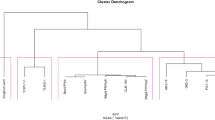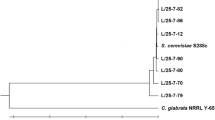Abstract
The Saccharomyces cerevisiae has been used for many years in the elaboration of food and beverage products, mainly associated with fermentation processes. The objective of this study was to characterize different indigenous S. cerevisiae strains and guide the notable strains for potential use in productions of fermented maize-based beverages. Initially, 81 strains isolated from different spontaneous food fermentations were evaluated. About 31% of strains showed phytase activity, an important characteristic for their application in cereals beverages production. All strains were able to grow in pH values 2.0, 3.0, and 5.0 and the presence of 5, 15, and 30% of glucose, but none could grow at 42 °C. Only 29.6% of the evaluated strains were able to efficiently grow in up to 1.0 mol L−1 of NaCl. The Rep-PCR and RAPD-PCR tools showed that the strains were differently grouped by the two techniques, and the grouping was not completely correlated with isolation source. A total of 65 volatile compounds were identified from the maize beverage produced. The profiles of volatile compounds produced by the strains were strain specific. S. cerevisiae strains isolated from the same source showed different chemical and genetic profiles, emphasize the importance to characterize the performance of each strain when searching for starter culture to develop or improve fermented beverages.


Similar content being viewed by others
References
Mussatto SI, Dragone G, Guimarães PMR, Silva JPA, Cameiro LM, Roberto IC, Vicente A, Domingues L, Teixeira JA (2010) Technological trends, global market and challenges of bio-ethanol production. Biotecnol Adv 28:817–830
Beato FB, Bergdahl B, Rosa CA, Foster J, Gombert AK (2016) Physiology of Saccharomyces cerevisiae strains isolated from Brazilian biomes: new insights into biodiversity and industrial applications. FEMS Yeast Res:16
Aidoo KE, Nout MJ, Sarkar PK (2006) Occurrence and function of yeast in Asian indigenous fermented foods. FEMS Yeast Res 6:30–39
Nout MJR (2009) Rich nutrition from the poorest-cereal fermentations in Africa and Asia. Food Microbiol 26:685–692
Poutanen K (2012) Past and future of cereal grains as food for health. Trends Food Sci Technol 25:58–62
United States Department of Agriculture (USDA) (2017) World Agricultural Supply and Demand Estimates—WASDE-569 (September 2017)
Chaves-López C, Serio A, Grande-Tovar C, Cuervo-Mullet R, Delgado-Ospina J, Paparella A (2014) Traditional fermented foods and beverages from a microbiological and nutritional perspective: the Colombian heritage. Compr Rev Food Sci Food Saf 13:1031–1048
Schwan RF, Ramos CL (2019) Functional beverages from cereals. In: Grumezescu A, Holban A-M (eds) Functional and Medicinal Beverages. 1aed. Elsevier, Amsterdam, pp 351–379
Ejigui J, Savoie L, Marin J, Desrosiers T (2005) Beneficial changes and drawbacks of a traditional fermentation process on chemical composition and antinutritional factors of yellow maize (Zea mays). J Biol Sci 5:590–596
Singh AK, Rejal J, Kaur A, Jyot G (2015) Enhancement of attributes of cereals by germination and fermentation: a review. Crit Rev Food Sci Nutr 55:1575–1589
Griffiths DW, Birch ANE, Hillman JR (1998) Antinutritional compounds in the Brassicaceae: analysis, biosynthesis, chemistry and dietary effects. J Hortic Sci Biotechnol 73:1–18
Tofalo R, Fusco V, Böhnlein C, Kabisch J, Logrieco AF, Habermann D, Cho G-S, Benomar N, Abriouel H, Schmidt-Heydt M, Neve H, Bockelmann W, Franz CMAP (2019) The life and times of yeasts in traditional food fermentations. Crit Rev Food Sci Nutr 26:1–30. https://doi.org/10.1080/10408398.2019.1677553
Raghavendra P, Halami PM (2009) Screening, selection and characterization of phytic acid degrading lactic acid bacteria from chicken intestine. Int J Food Microbiol 133:129–134
Ries EF, Macedo GA (2009) Progressive screening of thermostable yeasts for phytase production. Food Sci Biotechnol 18:665–660
Breisha GZ (2010) Production of 16% ethanol from 35% sucrose. Biomass Bioenergy 34:1243–1249
Ramos CL, Thorsen L, Schwan RF, Jespersen L (2013) Strain-specific probiotics properties of Lactobacillus fermentum, Lactobacillus plantarum and Lactobacillus brevis isolates from Brazilian food products. Food Microbiol 36:22–29
Pereira GVDM, Miguel MGDCP, Ramos CL, Schwan RF (2012) Microbiological and physicochemical characterization of small-scale cocoa fermentations and screening of yeast and bacterial strains to develop a defined starter culture. Appl Environ Microbiol 78:5395–5405
Versalovic J, Schneider M, de Bruijn F, Lupski JR (1994) Genomic fingerprint of bacteria using repetitive sequence-based polymerase chain reaction. Methods Mol Cell Biol 5:25–40
Silva WPK, Multani DS, Deverall BJ, Lyon BR (1995) RFLP and RAPD analyses in the identification and differentiation of isolates of the leaf spot fungus Corynespora cassiicola. Aust J Bot 43:609–618
Miguel MGDCP, Santos MRRM, Duarte WF, de Almeida EG, Schwan EF (2012) Physico-chemical and microbiological characterization of corn and rice ‘calugi’ produced by Brazilian Amerindian people. Food Res Int 49:524–532
Duarte WF, Dias DR, Oliveira JM, Teixeira JA, Silva JBDA, Schwan RF (2010) Characterization of different fruit wines made from cacao, cupuassu, gabiroba, jaboticaba and umbu. LWT Food Sci Technol 43:1564–1572
Ogunremi OR, Banwo K, Sanni AI (2017) Starter-culture to improve the quality of cereal-based fermented foods: trends in selection and application. Curr Opin Food Sci 13:38–43
Hellström AM, Vazques-Juárez R, Svanberg U, Andlid TA (2010) Biodiversity and phytase capacity of yeasts isolated from Tanzanian togwa. Int J Food Microbiol 136:352–358
Attfield PV (1997) Stress tolerance: the key to effective strains of industrial baker’s yeast. Nat Biotechnol 15:1351–1357
Rep M, Krantz M, Thevelein JM, Hohmann S (2000) The transcriptional response of Saccharomyces cerevisiae to osmotic shock. J Biol Chem 275:8290–8300
Fleet GH (2008) Wine yeasts for the future. FEMS Yeast Res 8:979–995
Crauwels S, Zhu B, Steensels J, Busschaert P, Samblanx GD, Marchal K, Willems KA, Verstrepen KJ, Lievens B (2014) Assessing genetic diversity among Brettanomyces yeasts by DNA fingerprinting and whole-genome sequencing. Appl Environ Microbiol 80:4398–4413
Nielsen DS, Teniola OD, Ban-Koffi L, Owusu M, Andersson TS, Holzapfel WH (2007) The microbiology of Ghanaian cocoa fermentations analysed using culture dependent and culture independent methods. Int J Food Microbiol 114:168–186
Visintin S, Alessandria V, Valente A, Dolci P, Cocolin L (2016) Molecular identification and physiological characterization of yeasts, lactic acid bacteria and acetic acid bacteria isolated from heap and box cocoa bean fermentations in West Africa. Int J Food Microbiol 4:69–78
Santos CCAA, Almeida EG, Melo GVP, Schwan RF (2012) Microbiological and physicochemical characterisation of caxiri, an alcoholic beverage produced by the indigenous Juruna people of Brazil. Int J Food Microbiol 156:112–121
Brasil. (2009) DECRETO N° 6.871, DE 4 DE JUNHO DE 2009. Regulamenta a Lei no 8.918, de 14 de julho de 1994, que dispõe sobre a padronização, a classificação, o registro, a inspeção, a produção e a fiscalização de bebidas. Legislação Bebidas. Presidência da República. http://www.planalto.gov.br/ccivil_03/_Ato20072010/2009/Decreto/D6871.htm2010/2009/Decreto/D6871.htm./ (web archive link, 20 February 2018). (Accessed 20.02.2018)
Walker GM, Stewart GG (2016) Saccharomyces cerevisiae in the production of fermented beverages. Beverages 2:30
Blandino A, Al-Aseeri M, Pandiella S, Cantero D, Webb C (2003) Cereal-based fermented foods and beverages. Food Res Int 36:527–543
Roger T, Léopold TN, Funtong MM (2015) Nutritional properties and antinutritional factors of corn paste (Kutukutu) fermented by different strains of lactic acid bacteria. Int J Food Sci 2015:1–14
Freire AL, Ramos CL, Schwan RF (2017) Effect of symbiotic interaction between a fructooligosaccharide and probiotic on the kinetic fermentation and chemical profile of maize blended rice beverages. Food Res Int 100:698–707
Longo MA, Sanromán MA (2006) Production of food aroma compounds. Food Technol Biotechnol 44:335–353
Frauendorfer F, Schieberle P (2008) Changes in key aroma compounds of Criollo cocoa beans during roasting. J Agric Food Chem 56:10244–10251
Luna F, Crouzillat D, Cirou L, Bucheli P (2002) Chemical composition and flavor of Ecuadorian cocoa liquor. J Agric Food Chem 50:3527–3532
Hagedorn S, Kaphammer B (1994) Microbial biocatalysis in the generation of flavor and fragrance chemicals. Annu Rev Microbiol 48:773–800
Availability of data and materials
All data generated or analyzed during this study are included in this published article.
Funding
The authors received financial support from the Brazilian agencies Conselho Nacional de Desenvolvimento Científico e Tecnológico do Brasil (CNPq), Fundação de Amparo à Pesquisa do Estado de Minas Gerais (FAPEMIG), and Coordenação de Aperfeiçoamento de Pessoal de Nível Superior (CAPES).
Author information
Authors and Affiliations
Contributions
JV analyzed and interpreted the data and writing of the manuscript. LV, CR, and RS contributed to the orientation and writing of the manuscript. All authors read and approved the final manuscript.
Corresponding author
Ethics declarations
Conflicts of interest
The authors declare that they have no conflict of interest.
Ethics approval
Not applicable.
Consent to participate
Not applicable.
Consent for publication
Not applicable.
Code availability
Not applicable
Additional information
Responsible Editor: Gisele Monteiro.
Publisher’s note
Springer Nature remains neutral with regard to jurisdictional claims in published maps and institutional affiliations.
Electronic supplementary material
ESM 1
(DOCX 44 kb)
Rights and permissions
About this article
Cite this article
de Almeida Silva Vilela, J., de Figueiredo Vilela, L., Ramos, C.L. et al. Physiological and genetic characterization of indigenous Saccharomyces cerevisiae for potential use in productions of fermented maize-based-beverages. Braz J Microbiol 51, 1297–1307 (2020). https://doi.org/10.1007/s42770-020-00271-8
Received:
Accepted:
Published:
Issue Date:
DOI: https://doi.org/10.1007/s42770-020-00271-8




